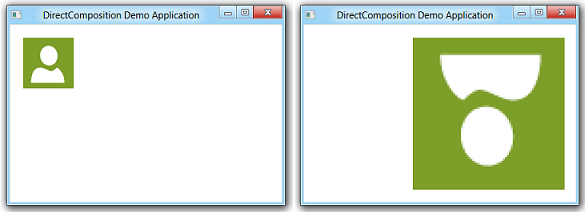如何套用 2D 轉換
注意
針對Windows 10上的應用程式,我們建議使用 Windows.UI.Composition API,而不是 DirectComposition。 如需詳細資訊,請參閱 使用視覺層將傳統型應用程式現代化。
本主題示範如何使用 Microsoft DirectComposition 將 2D 轉換套用至視覺效果。 本主題中的範例會套用一組轉換::
- 將視覺效果旋轉 180 度。
- 將視覺效果相應增加為其原始大小的三倍。
- 轉譯 () 視覺效果的原始位置右邊 150 圖元移動。
下列螢幕擷取畫面顯示套用 2D 轉換前後的視覺效果。

您所需了解的事情
技術
必要條件
- C/C++
- Microsoft Win32
- 元件物件模型 (COM)
指示
步驟 1:初始化 DirectComposition 物件
- 建立裝置物件和組合目標物件。
- 建立視覺效果、設定其內容,並將其新增至視覺化樹狀結構。
如需詳細資訊,請參閱 如何初始化 DirectComposition。
步驟 2:建立轉換群組陣列
IDCompositionTransform *pTransforms[3];
步驟 3:建立轉換物件、設定其屬性,並將其新增至轉換群組陣列
- 使用 IDCompositionDevice::CreateRotateTransform、 ::CreateScaleTransform和 ::CreateTranslateTransform 方法來建立轉換物件。
- 使用 IDCompositionRotateTransform、 IDCompositionScaleTransform和 IDCompositionTransform 介面的成員函式來設定轉換的屬性。
- 將轉換介面指標複製到轉換群組陣列。
IDCompositionRotateTransform *pRotateTransform = nullptr;
IDCompositionScaleTransform *pScaleTransform = nullptr;
IDCompositionTranslateTransform *pTranslateTransform = nullptr;
IDCompositionTransform *pTransformGroup = nullptr;
// Create the rotate transform.
hr = pDevice->CreateRotateTransform(&pRotateTransform);
if (SUCCEEDED(hr))
{
// Set the center of rotation to the center point of the visual.
hr = pRotateTransform->SetCenterX(BITMAP_WIDTH/2.0f);
if (SUCCEEDED(hr)) {
hr = pRotateTransform->SetCenterY(BITMAP_HEIGHT/2.0f);
}
// Set the rotate angle to 180 degrees.
if (SUCCEEDED(hr)) {
hr = pRotateTransform->SetAngle(180.0f);
}
// Add the rotate transform to the transform group array.
pTransforms[0] = pRotateTransform;
// Create the scale transform.
if (SUCCEEDED(hr)) {
hr = pDevice->CreateScaleTransform(&pScaleTransform);
}
}
if (SUCCEEDED(hr))
{
// Set the scaling origin to the upper-right corner of the visual.
hr = pScaleTransform->SetCenterX(0.0f);
if (SUCCEEDED(hr)) {
hr = pScaleTransform->SetCenterY(0.0f);
}
// Set the scaling factor to three for both the width and height.
if (SUCCEEDED(hr)) {
hr = pScaleTransform->SetScaleX(3.0f);
}
if (SUCCEEDED(hr)) {
hr = pScaleTransform->SetScaleY(3.0f);
}
// Add the scale transform to the transform group array.
pTransforms[1] = pScaleTransform;
// Create the translate transform.
if (SUCCEEDED(hr)) {
hr = pDevice->CreateTranslateTransform(&pTranslateTransform);
}
}
if (SUCCEEDED(hr))
{
// Move the visual 150 pixels to the right.
hr = pTranslateTransform->SetOffsetX(150.0f);
if (SUCCEEDED(hr)) {
hr = pTranslateTransform->SetOffsetY(0.0f);
}
// Add the translate transform to the transform group array.
pTransforms[2] = pTranslateTransform;
}
步驟 4:建立轉換群組物件
呼叫 IDCompositionDevice::CreateTransformGroup 方法來建立轉換群組物件。
if (SUCCEEDED(hr))
{
// Create the transform group.
hr = pDevice->CreateTransformGroup(pTransforms, 3, &pTransformGroup);
}
步驟 5:將轉換群組物件套用至視覺效果
使用 IDCompositionVisual::SetTransform 方法,將視覺效果的 Transform 屬性與轉換群組物件產生關聯。
if (SUCCEEDED(hr))
{
// Apply the transform group to the visual.
hr = pVisual->SetTransform(pTransformGroup);
}
步驟 6:認可組合
呼叫 IDCompositionDevice::Commit 方法,將視覺效果的更新認可至 DirectComposition 進行處理。 套用 2D 轉換群組的結果會出現在目標視窗中。
if (SUCCEEDED(hr))
{
// Commit the composition.
hr = pDevice->Commit();
}
步驟 7:釋放 DirectComposition 物件
當您不再需要 2D 轉換物件時,請務必釋放這些物件群組。 下列範例會呼叫應用程式定義的 SafeRelease 宏,以釋放轉換物件。
// Release the transform objects.
for (int i = 0; i < 3; i++)
{
SafeRelease(&pTransforms[i]);
}
也請記得在應用程式結束之前釋放裝置物件、組合目標物件和視覺效果。
完整範例
#define BITMAP_WIDTH 80.0
#define BITMAP_HEIGHT 80.0
HRESULT DemoApp::ApplyTransformGroup(IDCompositionDevice *pDevice,
IDCompositionVisual *pVisual)
{
HRESULT hr = S_OK;
if (pDevice == nullptr || pVisual == nullptr)
return E_INVALIDARG;
IDCompositionTransform *pTransforms[3];
IDCompositionRotateTransform *pRotateTransform = nullptr;
IDCompositionScaleTransform *pScaleTransform = nullptr;
IDCompositionTranslateTransform *pTranslateTransform = nullptr;
IDCompositionTransform *pTransformGroup = nullptr;
// Create the rotate transform.
hr = pDevice->CreateRotateTransform(&pRotateTransform);
if (SUCCEEDED(hr))
{
// Set the center of rotation to the center point of the visual.
hr = pRotateTransform->SetCenterX(BITMAP_WIDTH/2.0f);
if (SUCCEEDED(hr)) {
hr = pRotateTransform->SetCenterY(BITMAP_HEIGHT/2.0f);
}
// Set the rotate angle to 180 degrees.
if (SUCCEEDED(hr)) {
hr = pRotateTransform->SetAngle(180.0f);
}
// Add the rotate transform to the transform group array.
pTransforms[0] = pRotateTransform;
// Create the scale transform.
if (SUCCEEDED(hr)) {
hr = pDevice->CreateScaleTransform(&pScaleTransform);
}
}
if (SUCCEEDED(hr))
{
// Set the scaling origin to the upper-right corner of the visual.
hr = pScaleTransform->SetCenterX(0.0f);
if (SUCCEEDED(hr)) {
hr = pScaleTransform->SetCenterY(0.0f);
}
// Set the scaling factor to three for both the width and height.
if (SUCCEEDED(hr)) {
hr = pScaleTransform->SetScaleX(3.0f);
}
if (SUCCEEDED(hr)) {
hr = pScaleTransform->SetScaleY(3.0f);
}
// Add the scale transform to the transform group array.
pTransforms[1] = pScaleTransform;
// Create the translate transform.
if (SUCCEEDED(hr)) {
hr = pDevice->CreateTranslateTransform(&pTranslateTransform);
}
}
if (SUCCEEDED(hr))
{
// Move the visual 150 pixels to the right.
hr = pTranslateTransform->SetOffsetX(150.0f);
if (SUCCEEDED(hr)) {
hr = pTranslateTransform->SetOffsetY(0.0f);
}
// Add the translate transform to the transform group array.
pTransforms[2] = pTranslateTransform;
}
if (SUCCEEDED(hr))
{
// Create the transform group.
hr = pDevice->CreateTransformGroup(pTransforms, 3, &pTransformGroup);
}
if (SUCCEEDED(hr))
{
// Apply the transform group to the visual.
hr = pVisual->SetTransform(pTransformGroup);
}
if (SUCCEEDED(hr))
{
// Commit the composition.
hr = pDevice->Commit();
}
// Release the transform objects.
for (int i = 0; i < 3; i++)
{
SafeRelease(&pTransforms[i]);
}
// Release the transform group pointer.
SafeRelease(&pTransformGroup);
return hr;
}
相關主題